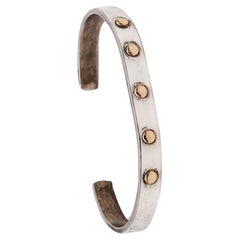65 Inch Women Bracelets
Recent Sales
Vintage 1970s French Modern Cuff Bracelets
Gold, 14k Gold, Yellow Gold, Silver, Sterling Silver
Pierre Cardin for sale on 1stDibs
Best known for creating groundbreaking fashion designs from the 1950s onward, Pierre Cardin enjoyed great success in other design fields, most notably furniture. Cardin’s chairs, cabinets, tables and other pieces share many of the keynotes of his clothing designs. They are simple, geometric, elegant and cool.
Cardin was born in a village near Venice, Italy, and raised in central France. Always interested in fashion, he left home at age 17 to train with a Vichy tailor. After the end of World War II, Cardin moved to Paris and worked for a succession of couture houses, before taking a job with Christian Dior in 1946. Cardin went solo in 1950, and quickly won attention for his novel style. Unlike Dior’s famous New Look, Cardin’s clothes de-emphasized a woman’s curves; his breakthrough pieces like the Bubble dress had, instead, a sculptural quality. In the following decade, Cardin introduced bright tunic dresses and shifts, marketed as the Space Age look and accessorized with vinyl hats and visors.
In the 1970s Cardin expanded his design work into furniture, jewelry and automobiles. (Later, licensing agreements would put Cardin’s name on goods ranging from perfume to sunglasses.) Cardin’s furniture pieces — inspired, perhaps, by the rediscovery of Art Deco design in that decade — feature simple, symmetrical forms, lacquer and figured veneer finishes, and accents in metals such as aluminum and brass.
Whether you are looking for a vintage cocktail dress or a chest of drawers to keep it in, as you will see on 1stDibs, Pierre Cardin offers an option in either that is timelessly chic.
A Close Look at modern Jewelry
Rooted in centuries of history of adornment dating back to the ancient world, modern jewelry reimagines traditional techniques, forms and materials for expressive new pieces. As opposed to contemporary jewelry, which responds to the moment in which it was created, modern jewelry often describes designs from the 20th to 21st centuries that reflect movements and trends in visual culture.
Modern jewelry emerged from the 19th-century shift away from jewelry indicating rank or social status. The Industrial Revolution allowed machine-made jewelry using electric gold plating, metal alloys and imitation stones, making beautiful jewelry widely accessible. Although mass production deemphasized the materials of the jewelry, the vision of the designer remained important, something that would be furthered in the 1960s with what’s known as the “critique of preciousness.”
A design fair called the “Exposition Internationale des Arts Décoratifs et Industriels Modernes” brought global attention to the Art Deco style in 1925 and gathered a mix of jewelry artists alongside master jewelers like Van Cleef & Arpels, Mauboussin and Boucheron. Art Deco designs from Cartier and Van Cleef & Arpels unconventionally mixed gemstones like placing rock crystals next to diamonds while borrowing motifs from eclectic sources including Asian lacquer and Persian carpets. Among Cartier’s foremost design preoccupations at the time were high-contrast color combinations and crisp, geometric forms and patterns. In the early 20th century, modernist jewelers like Margaret De Patta and artists such as Alexander Calder — who is better known for his kinetic sculptures than his provocative jewelry — explored sculptural metalwork in which geometric shapes and lines were preferred over elaborate ornamentation.
Many of the innovations in modern jewelry were propelled by women designers such as Wendy Ramshaw, who used paper to craft her accessories in the 1960s. During the 1970s, Elsa Peretti created day-to-night pieces for Tiffany & Co. while designers like Lea Stein experimented with layering plastic, a material that had been employed in jewelry since the mid-19th century and had expanded into Bakelite, acrylics and other unique materials.
Find a collection of modern watches, bracelets, engagement rings, necklaces, earrings and other jewelry on 1stDibs.
Finding the Right cuff-bracelets for You
There is no shortage of iconic bracelet designs out there: Cartier’s Love bracelet, the widely admired Panthère, the Croisillon bracelet crafted by Jean Schlumberger for Tiffany & Co., to name a few. And while you don’t necessarily need one of history’s most coveted versions of this accessory, you’re likely going to want at least a reliable collection of vintage cuff bracelets in your jewelry box.
Cuff bracelets are fashion staples. This stylish go-to — a rigid bracelet, open or outfitted with a clasp that snaps shut, understated and unadorned or enameled and flecked with gemstones — goes back thousands of years.
Cuffs were worn by Greek and Roman soldiers as they headed into battle as well as by the men and women of Ancient Egypt as statement-making jewelry. In ancient China, jade was considered the most precious of stones, and a jade cuff bracelet or bangle was associated with purity and goodness. Jewelers also employed jade, as well as coral and lapis lazuli, during the Art Deco period, finding inspiration in all kinds of influences and frequently working geometric motifs into their Art Deco cuff bracelets.
Today, people love how a bejeweled cuff bracelet elevates a simple jeans-and-T-shirt ensemble or that a minimalist one pairs with formal wear so well. Indeed, it’s a fine finishing touch whether you’re dining with friends in your neighborhood or pairing your silver or gold cuff with an elegant evening dress on the red carpet.
On 1stDibs, find a wide variety of vintage cuff bracelets today.
